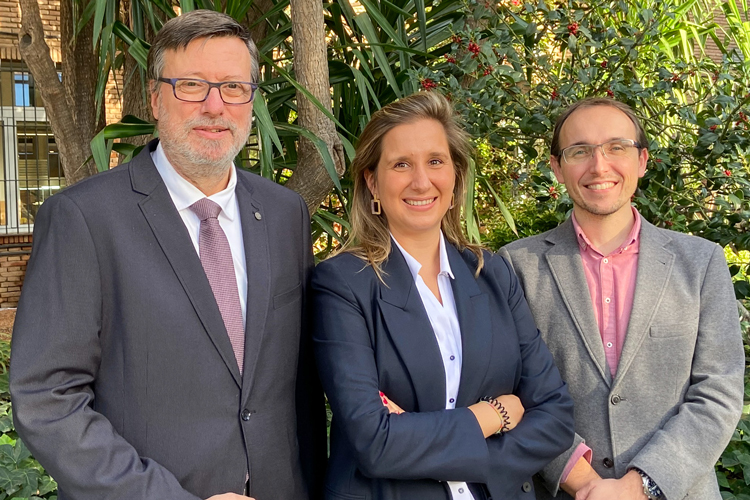In her doctoral thesis, Dr Leticia Manén has implemented a chemoinformatics methodology based on the selection of potentially active molecules, going far beyond the processes of hit-to-lead optimization and the claimed Markush space.

Dr Jordi Teixidó, Dr Leticia Manén, and Dr Roger Estrada
Drug discovery strategies are long, inefficient, and very expensive. One of its main stages is based on the optimization process known as hit-to-lead, where a search is made around the first "hits" found to be able to select a candidate with therapeutic potential. This process involves extensive study and subsequent synthesis of analogues of a molecule that has previously exhibited certain biological activity against a particular target. This involves the synthesis of many derivatives that would lead to the description of a "chemical sub-library" which turns out to be very focused around the chemical space of the initial compound. Even so, when the molecule is finally patented, a much wider chemical space is protected through a Markush structure, assuming that the activity of the patented molecules can also be expanded to all its multiple derivatives.
Within this context, Dr Leticia Manén recently defended her doctoral thesis at IQS, entitled Exploring Molecular Diversity: There is plenty of room at Markush's, in which she worked under the hypothesis that much of the chemical space in these libraries remains unexplored and that more drug candidates could be found that may even surpass the activity of the original hit. She conducted her thesis within the Molecular Design Laboratory at the IQS School of Engineering, as part of the Pharmaceutical Chemistry Group led by Dr Jordi Teixidó and Dr Roger Estrada.
In her research, Dr Manén conducted an exploration of the resulting broad chemical space of small molecules with drug-like properties, using the ChEMBL bioactive molecule database and the list of FDA-approved drugs between 2008 and 2020. Her ultimate objective was to implement and demonstrate the advantages of the exploratory methodology compared to the research that is currently established in the medicinal chemical field. The results obtained, based on computational technology, have confirmed that both rational and random selection represent the combinatorial libraries declared in the patents in a more significant way than the molecules described so far.
New chemoinformatics methodology for the selection of active molecules
The established methodology – a combination of computational and experimental chemistry – best describes the chemical space of a particular drug: it consists of the rational choice of certain specific molecules from the previous definition of molecular databases, the subsequent division of the space into clusters or cells, and a new selection of the molecules located at the centre of these spaces to finally proceed to their synthesis and study their activity.
As proof of concept, the methodology developed in her thesis has been implemented in two specific cases: that of the antimalarial drug Tafenoquine and the case of Dacomitinib, a second generation tyrosine kinase inhibitor for the treatment of non-small cell lung cancer. Exploration of the chemical space of these two families has led to the synthesis of seven antimalarial analogues and eight tyrosine kinase inhibitors that have shown interesting biological activities.
The study of the chemical space of Tafenoquine has been carried out in collaboration with the GSK Global Health Unit, specifically with the research team led by Dr Francisco Javier Gamo.
Dr Manén's thesis demonstrates that the application of chemoinformatics to library selection can improve the ability to better inspect chemical datasets in order to identify new pre-candidate compounds, leaving the door open for subsequent hit-to-lead processes beyond the claimed Markush space.
Related publications
Leticia Manén, Jose.I. Borrell, Jordi Teixidó, Roger Estrada, Deconstructing Markush: improving the R&D efficiency using library selection in early drug discovery, Pharmaceuticals 2022, 15(9), 1159
Esta tesis ha recibido financiación con fondos propios del Departamento de Química Orgánica y Farmacéutica y dentro del programa de ayudas IQS para la contratación de personal investigador predoctoral.










